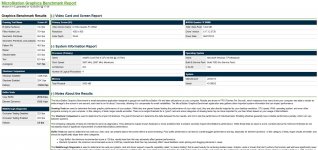MicroStation Graphics Benchmark Report
Version 8.11.5, generated on 12/30/2010 @ 17:35
Graphics Benchmark Results
--------------------------------------------------------------------------------
Drawing Test Name Screen #1
B-Spline Surfaces 53.8 fps
Filled Hidden Line 64.1 fps
Geometric Primitives 40.8 fps
Geometric Primitives (Anti-Aliased) 28.1 fps
Pattern Fill 35.9 fps
Raster 31.4 fps
Shaded Mesh 31.4 fps
Text 61.4 fps
Average(s) 43.4 fps
Shadows Comparison
Shadows Disabled 889.1 fps
Shadows Enabled 151.8 fps
Delta(s) -737.3 fps
Buffer Tests
Copy Buffer 1483.6 fps
Element Dynamics 5251.4 fps
Walkthrough Diagnostic
Occlusion Testing Disabled 24.8 fps
Occlusion Testing Enabled 17.3 fps
Delta(s) -7.5 fps
(-) Video Card and Screen Report
--------------------------------------------------------------------------------
Primary Screen (#1)
Video Device Name NVIDIA Quadro FX 880M
Resolution 1920 x 1080
Color Depth 32-bit
NVIDIA Quadro FX 880M
Total Video RAM 1024 MB
Driver Version 8.17.12.5738
Driver Date 06/27/2010
(+) System Information Report
--------------------------------------------------------------------------------
Processor (Primary)
Name Intel(R) Core(TM) i7 CPU Q 820 @ 1.73GHz
Clock Speed 1734 MHz (1734 MHz Maximum)
Architecture x64
Number of Logical Processors 8
Memory
Total Physical 8123 MB
Operating System
Name Microsoft Windows 7 Professional
Build & Service Pack Build 7600 (No Service Pack)
Is 64-bit Yes
System
Manufacturer LENOVO
Model 431929G
(+) Notes About the Results
--------------------------------------------------------------------------------
The MicroStation Graphics Benchmark is small standalone application designed to gauge how well MicroStation XM and later will perform on your computer. Results are shown in FPS (Frames Per Second), which measures how many times your computer was able to render an entire image to the screen in one second; each test is run for about 3 seconds, allowing it to compensate for small variabilities. The MicroStation Graphics Benchmark application also gathers other important system information that can impact performance.
Drawing Tests are used to determine the basic graphic performance of your system. While they are geared toward testing the performance of your video card, they are also directly impacted by your desktop resolution, CPU speed, RAM, operating system, and even other programs running on your computer. In this category of tests, larger results are better. There is no single threshold for a "good" card and some categories of drawing tests may be more important to you than others based on your usage of MicroStation.
The Shadows Comparison is used to determine the impact of shadows. The goal of this test is to determine the delta between the two results, and not to rate the performance of individual tests. Enabling shadows generally has a notable performance penalty, which can vary between systems.
The remaining categories of tests are intended to serve as diagnostics. They attempt to expose known hardware or driver problems that, if present, severely impact MicroStation's performance. While these tests do report a score, numbers above the minimum threshold do not necessarily result in significant improvement of overall MicroStation performance.
Buffer Tests are used to determine how well your video card can present data to the screen after it is done rendering. Poor buffer performance can lead to overall sluggish performance and lag, especially for element dynamics. In this category of tests, larger results are better, and should be significantly larger than other categories.
Copy Buffer: the minimum recommended score is 100 fps; results less than this may adversely affect general performance.Element Dynamics: the minimum recommended score is 2,500 fps; results less than this may adversely affect visual feedback when picking and dragging elements in views.The Walkthrough Diagnostic is used to determine how well your graphic card and driver support a specific capability called "occlusion testing" that is used heavily for rendering shaded views. Graphic cards or drivers that don’t perform this function well will have significantly lower frame rates and may appear “sluggish” when rotating shaded views or performing walkthroughs. The goal of this test is to determine the delta between the two results, and not to rate the performance of individual tests. Most systems will have a positive delta (e.g. 10% or more). A negative delta suggests that your graphic card or driver does not adequately perform occlusion testing. If this is the case, you may wish to forcefully disable it in MicroStation (use the "view quickscan off" keyin).









